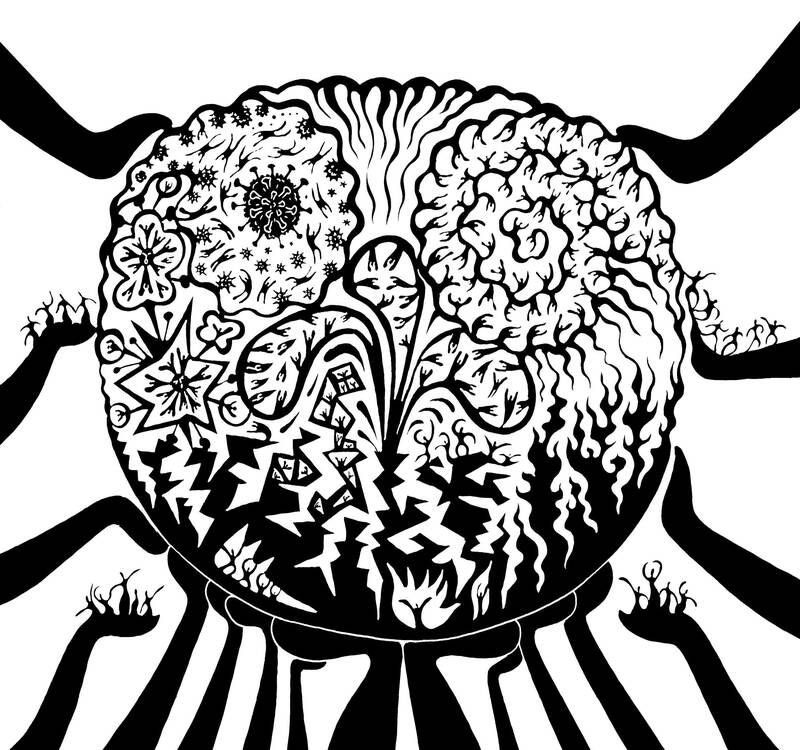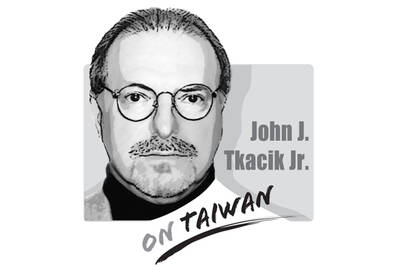After a week that started with the worst financial volatility in recent history and ended with the most serious escalation so far of the China-US conflict, it is time to distinguish the tectonic shifts from the tremors. If nothing changes, the 2020s risks being remembered as this century’s devil’s decade — the term historians once used for the 1930s. It would be defined not just by 7 million people who have died of COVID-19 and rising global poverty and inequality — but also by a dismembered Ukraine, a burnt-out Gaza, and little-reported atrocities in Africa and Asia, each testimony to the violent displacement of a rules-based global order by a power-based one.
Indeed, before our eyes, every single pillar of the old order is under assault — not just free trade, but the rule of law and the primacy we have long attached to human rights and democracy, the self-determination of peoples and multilateral cooperation between nations, including the humanitarian and environmental responsibilities we once accepted as citizens of the world.
Power shifts are, of course, the stuff of history. Within the space of two centuries, four world orders have risen and fallen. The first two — the balance of power that emerged after the defeat of Napoleon in the early 19th century, and the post-1918 Treaty of Versailles system born after four dynastic empires collapsed — ultimately ended in the carnage of world wars. Then came the post-1945 architecture, led by the US and the UN; and, after 1990 with the breakup of the Soviet Union and the Warsaw Pact, what former US president George H.W. Bush called a “new world order.”

Illustration: Mountain People
Now, as the economic balance of power shifts eastward and a new mercantilism takes root, what was once called the Washington consensus is no longer supported anywhere — least of all in Washington. Globalization is now rejected by millions as a “free for all” that has not been fair to all. It is not open trade, but the opposite — restrictions on trade — now being popularized as a nation’s route to prosperity.
US President Donald Trump’s tactical ploy has been to exploit the profound shifts that were already reshaping the world’s geopolitics: First, the yawning gap between the benefits that globalization promised and what it delivered in people’s everyday lives, and so he has become the world’s leading anti-globalist.
He also saw how, turbo-charged by social media blitzes landing nonstop via people’s phones, he could resurrect the “great man” theory of history — Russian President Vladimir Putin, Chinese President Xi Jinping (習近平), Turkish President Recep Tayyip Erdogan and North Korean leader Kim Jong-un having shown him that populist, but dictatorial leaders could set the agenda.
However, Trump’s sheer unpredictability foreshadows even greater danger ahead. “Let chaos reign and don’t rein in the chaos” seems to be the mantra, and while there might be a lingering hope that something like normal governance might resume soon, this can no longer be a rational basis for anyone’s future planning. Instead, with both the US and China taking risks in accelerating their confrontation to new levels, the question is whether we are descending toward a “one world, two systems” future, or simply the chaotic disorder that has characterized the history of most previous centuries — and whether there is now any chance of building a world order that could ever be stable and sustainable.
What is clear after recent events is that the fourth global order cannot be restored. We are not only in a more protectionist era, but are moving from a unipolar world where the US was the sole hegemonic power to one that has many more centers of decisionmaking power.
However, because we are also a more interconnected world, we are more vulnerable to crises — from pandemics and climate emergencies to financial contagion. All the more so because countries can, as we saw this past week, weaponize that interdependence and the choke points it creates for their own advantage. So if we are to have anything approaching a values-based order, we will have at some point to agree an updated global charter for our common future, something that builds on the Atlantic Charter of 1941 and the UN Charter of 1945, but is geared to a completely different century.
As William Beveridge said at that time: “A revolutionary moment in the world’s history is a time for revolutions, not for patching.” Over the past few days, calls for multilateral cooperation have come from the leaders of Spain, Brazil and South Africa, this year’s chairs of three global conferences: the 4th International Conference on Financing for Development, the 30th UN climate change conference and the G20.
“As a collective we must now unite to enforce international law,” the Malaysian prime minister and Colombian and South African presidents have written. “The choice is stark: Either we act together to enforce international law or we risk its collapse.”
All countries that believe in international cooperation should pledge that through a new multilateralism, this generation would deliver global solutions to what are now inescapably global problems that cannot be resolved by nation states acting on their own or in bilateral deals alone.
Second, as building blocks of that future, this collation of the willing should immediately engage in practical cooperation on urgent concerns for which no nation state-only answers are possible — global security, climate, health and humanitarian needs, as well as the flow of trade. They should work to modernize the international institutions that deliver them.
And third, we should try to build a bridgehead to skeptics such as Trump by agreeing with him on the need for reciprocity and for fair burden-sharing between nations; and because this is a debt-laden world we should propose innovative and equitable ways to raise the resources needed to turn these commitments into action. By addressing the failures of the era of hyper-globalization, we can all strive for a world that is not only open to trade, but inclusive of all those who have been left behind.
Two hundred years ago, in similarly momentous times, a British leader called “a new world into existence to redress the balance of the old,” and the lesson of history is that any new order that endures has to be built on the solid rock of principle, and not the shifting sands of expediency and the narrowest interpretation of national self-interests.
At the heart of the Atlantic Charter — the declaration of international cooperation inspired by former US president Franklin D. Roosevelt — was a set of principles celebrating basic freedoms — against the use of force and protectionism, and for the self-determination of nations and national social contracts that would bridge the divide between rich and poor.
Even if none of these goals are, as of now, championed by Trump, all is not lost: According to the US Global Leadership Coalition, 82 percent of Americans oppose isolationism, believing that the US is stronger when “engaged in the world.” And while the US can no longer lead a unipolar world by dictating to others, it can lead a multipolar world through persuasion.
Sadly, despite British Prime Minister Keir Starmer’s valiant efforts, none of us can now guarantee that Ukraine — and its resources — would not be carved apart, emboldening autocrats everywhere. However, we can set out the moral compass that will guide us and make us better prepared for the challenges ahead. We remain at risk of repeating the 1930s descent into global anarchy; but with nations acting together, we could create a 1940s moment as we start on the herculean task of constructing the fifth world order of modern times.
Gordon Brown was British prime minister from 2007 to 2010.

Elbridge Colby, America’s Under Secretary of Defense for Policy, is the most influential voice on defense strategy in the Second Trump Administration. For insight into his thinking, one could do no better than read his thoughts on the defense of Taiwan which he gathered in a book he wrote in 2021. The Strategy of Denial, is his contemplation of China’s rising hegemony in Asia and on how to deter China from invading Taiwan. Allowing China to absorb Taiwan, he wrote, would open the entire Indo-Pacific region to Chinese preeminence and result in a power transition that would place America’s prosperity
A few weeks ago in Kaohsiung, tech mogul turned political pundit Robert Tsao (曹興誠) joined Western Washington University professor Chen Shih-fen (陳時奮) for a public forum in support of Taiwan’s recall campaign. Kaohsiung, already the most Taiwanese independence-minded city in Taiwan, was not in need of a recall. So Chen took a different approach: He made the case that unification with China would be too expensive to work. The argument was unusual. Most of the time, we hear that Taiwan should remain free out of respect for democracy and self-determination, but cost? That is not part of the usual script, and
All 24 Chinese Nationalist Party (KMT) lawmakers and suspended Hsinchu Mayor Ann Kao (高虹安), formerly of the Taiwan People’s Party (TPP), survived recall elections against them on Saturday, in a massive loss to the unprecedented mass recall movement, as well as to the ruling Democratic Progressive Party (DPP) that backed it. The outcome has surprised many, as most analysts expected that at least a few legislators would be ousted. Over the past few months, dedicated and passionate civic groups gathered more than 1 million signatures to recall KMT lawmakers, an extraordinary achievement that many believed would be enough to remove at
Behind the gloating, the Chinese Nationalist Party (KMT) must be letting out a big sigh of relief. Its powerful party machine saved the day, but it took that much effort just to survive a challenge mounted by a humble group of active citizens, and in areas where the KMT is historically strong. On the other hand, the Democratic Progressive Party (DPP) must now realize how toxic a brand it has become to many voters. The campaigners’ amateurism is what made them feel valid and authentic, but when the DPP belatedly inserted itself into the campaign, it did more harm than good. The